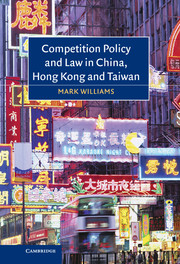Book contents
- Frontmatter
- Contents
- Preface
- Acknowledgements
- List of abbreviations
- 1 Introduction and methodology
- 2 Competition theory and the experience of states adopting competition law
- 3 The international perspective
- 4 China and economic regulation – history, politics and economics
- 5 Existing and proposed Chinese competition provisions
- 6 Competitive Hong Kong? myths, perception and reality
- 7 Implementation of competition policy in Hong Kong 1997–2004: economising with the truth
- 8 Electricity, telecommunication and broadcasting: competition regulation Hong Kong style
- 9 Taiwan - the third China
- 10 Political economy: an explanation of competition policy in Greater China
- 11 Competition policy and law in Greater China: where next?
- Bibliography
- Index
8 - Electricity, telecommunication and broadcasting: competition regulation Hong Kong style
Published online by Cambridge University Press: 28 July 2009
- Frontmatter
- Contents
- Preface
- Acknowledgements
- List of abbreviations
- 1 Introduction and methodology
- 2 Competition theory and the experience of states adopting competition law
- 3 The international perspective
- 4 China and economic regulation – history, politics and economics
- 5 Existing and proposed Chinese competition provisions
- 6 Competitive Hong Kong? myths, perception and reality
- 7 Implementation of competition policy in Hong Kong 1997–2004: economising with the truth
- 8 Electricity, telecommunication and broadcasting: competition regulation Hong Kong style
- 9 Taiwan - the third China
- 10 Political economy: an explanation of competition policy in Greater China
- 11 Competition policy and law in Greater China: where next?
- Bibliography
- Index
Summary
Introduction
The HKSAR government's public policy approach to competition regulation is founded on scepticism as to the need for, or desirability of, competition legislation. If competition failures can be identified and ‘proved’ to the government's satisfaction, consideration may be given to rectifying such proven market failures. Stated government policy is to employ exhortation to amend business practices, followed by administrative action to encourage change, with legislative intervention as very much a last resort. Such statutory intervention will be sector specific and confined to addressing only the competitive failures identified in the narrow sector to be regulated.
At first blush, this approach appears to be at least consistent with the government's philosophy of ‘small’ government and creative nonintervention in economic decision-making and might be thought to be a limited and proportionate response to specifically identified problems. This profound scepticism about the value of competition law does have some support from the academic authors of the economic freedom indices mentioned in the last chapter. But whether this analysis is correct is questionable.
Firstly, as has been demonstrated in chapter 7, the government's case that Hong Kong's domestic economy is a structurally free and open one is decidedly weak. Secondly, the assertion that competition problems are few and minor flies in the face of the available evidence. Thirdly, the government has no legal tools to undertake economic investigations to discover whether or not sectors of the domestic economy are competitive.
- Type
- Chapter
- Information
- Competition Policy and Law in China, Hong Kong and Taiwan , pp. 301 - 365Publisher: Cambridge University PressPrint publication year: 2005



